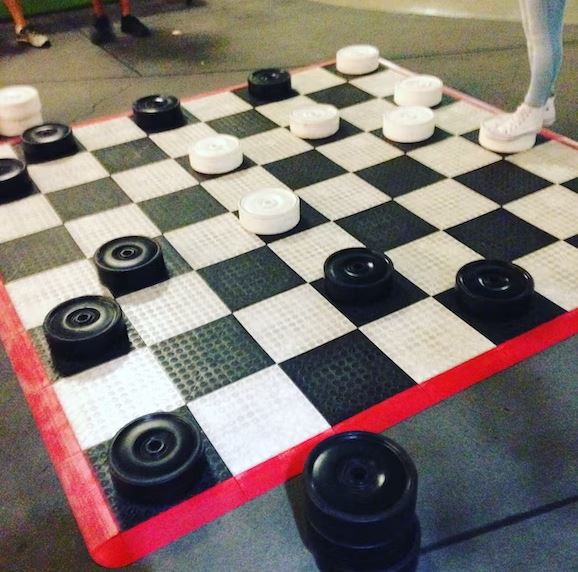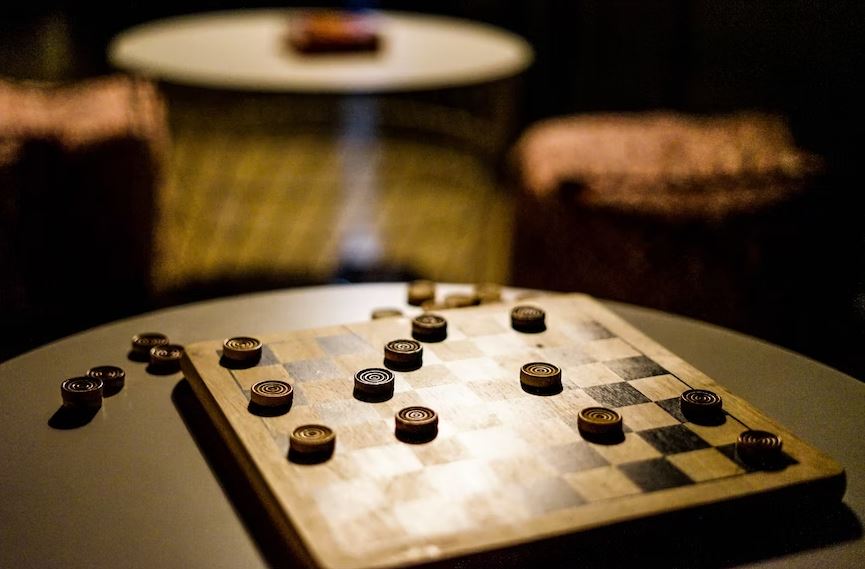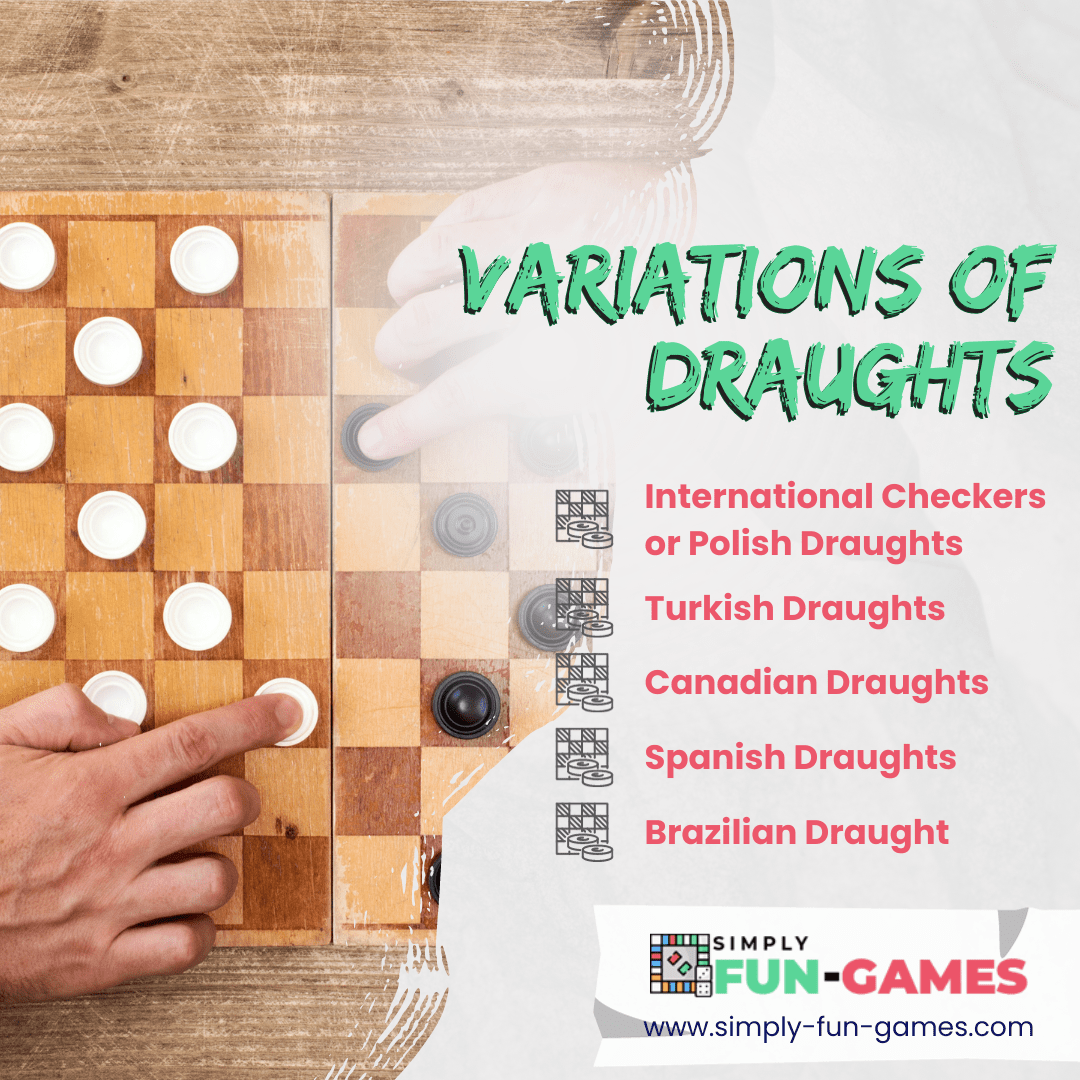Introduction
The game of draughts is a well-known game known by different names and can be played in different variations. For example, the game is called Checkers or English Draughts in America. It is also called Polish Draughts in Europe, played most frequently in international competitions throughout Western Europe. Although it is a very famous game, it is surprising to know that there are many people who don’t know how to play the game. This age-old board game is a fantastic way to relax with loved ones while sharpening your strategic thinking abilities. Although learning to play is simple, becoming an expert can take some time. Read on to learn essential details of the game, such as its rich history, how to move the pieces, take turns, and how to win the game. Once you’ve mastered these fundamentals, you’ll be prepared to move on to more sophisticated plans and techniques.
What is a game of Draughts?
Draughts, commonly known as checkers, is a classic board game played for ages worldwide. The game pieces are arranged on a 64-square checkerboard with alternately colored dark and light squares, with each player having 12 pieces of stones with two distinct colors such as black and white. The main objective of the game is to capture the opponent’s pieces by jumping over the opponent’s piece to remove it from the board. Players take turns hopping and capturing each other’s pieces to be the first to create a king to reach the opposite side of the board. Draughts is a difficult game that requires strategic skills, focus, and technique to outwit an opponent. Different nations and civilizations play draughts in a variety of ways, with each having its unique set of rules. Despite its apparent simplicity, draughts is a gripping game that is still played today.
History of Draughts
People of all ages enjoy playing draughts or checkers, as it is more commonly known in the United States. The eminent thinkers Plato and Homer were the ones who first made the game in their works of literature. They described a game that involved capturing an opponent’s pieces that originated in ancient Egypt. Napoleon Bonaparte, Fryderyk Chopin, Leo Tolstoy, Charles Darwin, and Benjamin Franklin are notable people who enjoyed playing checkers or draughts in their spare time. Draughts have been around for thousands, not just hundreds, of years.
1. Historical Theories on the Origin of Draughts
Historians considered ancient Egypt as the origin of board games, including draughts or checkers. The earliest known variations of the game date back to 3000 BC and were discovered in Ur during an archaeological excavation. Numerous illustrations found include an old draught playing kits, which showed men using a pair of dice and playing the game. This evidence dates back to about 2700 B.C. to the Age of the Pyramid Builder and the Old Kingdom. Archeologists have proven the existence of this game during the Egyptian era when pieces of a game that remarkably resembled draughts were discovered inside the burial chambers of the Egyptian Queen Hatsu. The Egyptians believed that the deity of wisdom and the inventor of writing (hieroglyphs), Thoth, created this game as a gift to men.
Before the discovery of the previously mentioned excavation, people believed that the game of checkers, or draughts, was similar to Alquerque, which Egyptians played in approximately 1400 B.C. The game’s rules, which were applied to a 5×5 board, were identical to modern checkers. Around 950 AD, the game was described as El-Quirkat in the Arabic songbook Kitab al-Aghani. The history of draughts can also be found in Greek mythology. Palamedes created the game Patteia during the siege of Troy, and the Romans altered it into the brigand game Latrunculi. Many scholars of the present time compare the ancient Roman sport of latruncula to contemporary draughts. The archeological proof was that a game like checkers was played before 1400 B.C. in the historic city-state of Ur, which used a board that resembles a checkerboard used today.
2. The Spread of Draughts Throughout Europe During the Middle Ages
Numerous advancements and modifications were made to the game of draughts before modern checkers or draughts emerged from myths of antiquity. Turning the draughts into the final game known today as draughts or checkers was a long, tedious process. The truth is that the Egyptian variant of checkers had become extremely popular before the game adopted the name “checkers .”It was much loved and performed by many people, so it persisted for a long time. It wasn’t until 1100AD that a Frenchman decided it was worthwhile to modify it so it could be played on a chessboard. He decided to expand the game’s component pieces from 5 to 12. These were the first and most significant alterations to the game in hundreds of years, and the updated version was named Ferses.
During the glorious Roman age, the game changed. Numerous historical references show Roman soldiers playing a game similar to draughts during the Trojan War. Similar game sets were also discovered in Italy, these games, which lacked dice or the play of chance, are the real forebears of the vibrant game now called draughts. Despite the numerous changes that the game has undergone, the fundamental idea of the game has stayed the same. It incorporates the idea of jumping to seize your opponents’ pieces. The game first reached Europe during the Moors’ dominion through Spain, then France, and finally the rest of the continent. Draughts continued to become a popular game in Britain by the 17th century. Many Britons made the decision to settle in the “New World,” or the Americas, during this period to try their luck. The cherished game crossed the Atlantic and is still a popular pastime in the United States and the United Kingdom.
3. Draughts Has Become an Official Game
The earliest checkers or draughts books that were written and published first appeared in the territories of Spain. Although no copy has been found today, historians assume that Antonio de Torquemada published the first book about checkers in Spanish in 1547. The National Library in Madrid is home to the earliest checkers-related work, called “El Andaluz” or Andalusian by Pedro Ruiz Montero, which dates to 1591.
The formal draughts rules, which were published in the book “An Introduction to the Game of Draughts” by the English mathematician William Payne in 1756, were the first guidelines used in playing the modern version of the game draughts. Since then, the game has gone by Draughts in the U.K. and Checkers in the United States. Draughts became well-known and acclaimed thanks to the formal rules and terminology of the game.
Soon later, in 1840, the inaugural English Draughts World Championship was held. More focus has been placed on tactics and strategy as the games have become more professional. Moreover, a new era in the game’s history was marked when Arthur L Samuels created the first Draughts software in 1952. The ideal move can be calculated by checkers computer systems of today by analyzing vast amounts of data. Since then, the game has reached millions of homes worldwide thanks to the inclusion of checkers programs in computers and the development of the internet.
Things You Need to Know to Play Draughts
Every game has its own rules, and draughts are no exception. The game is initially played between two opposing players on a chessboard. A typical chessboard has 64 squares or 8 × 8 alternate squares; however, some chessboards have up to 100 squares or 10 x 10 alternate squares. Draughts players divide the game into two main categories: international draughts, which is played on a 10×10 board or 100 fields, and traditional draughts, which is played on an 8×8 board or 64 fields. Typically, one player chooses the darker counters, composed of 12 pieces, and the other automatically chooses the lighter counters, with 12 pieces. The checker’s rule prohibits moving an opponent’s piece; only the board’s shaded squares are utilized. Here are more specific steps in playing draughts.
1. Setting up the Board Pieces and Defining the Objective of the Game
Setting up the board and draughts pieces is an essential step in playing this timeless game. The squares on the board, which alternate between dark and light colors, should always be positioned on a flat surface. The two players should then arrange their pieces on the board. Each player is given a total of 12 pieces; they should be placed on the dark squares that are nearest to them. After every piece is in place, the player with the dark-colored pieces takes the initiative and moves their piece one spot at a time down a diagonal line. Draughts players must always remember that only one piece may move every turn and never travel backward! It’s time to start the exciting strategy game now!
In every game, black always gets the first move. A tossed coin is usually done to determine who will be the black player. The player placed their pieces in the twelve black squares closest to them. The game solely uses the diagonal movement of the pieces, which keeps them on the black squares the entire time, while the white squares are never used. The game’s goal is to eliminate all your opponent’s pieces or create a situation in which they cannot move. Draughts is a two-player game that must be won by capturing all your opponent’s pieces or keeping them from moving around the board. But unlike Chess, Draughts rarely comes to a stalemate.
2. Draughts Game Play
A player may move one piece across the board on each turn. Only diagonal movements are allowed for regular pieces to advance. Jumping over an opponent’s pieces will allow a player to capture their pieces. Moreover, the player can capture a diagonal piece across from their piece. However, the player can only do this if the pieces the player wishes to capture are beyond a space to which the player’s object may jump. Jumping is capturing a piece; if a player is fortunate, the player can jump several pieces at once. Beginners should remember that moving back is strictly prohibited for regular pieces. But a king or queen is an extraordinary piece that can move backward, which is a rule exception.
3. Making a King or a Queen
A king or queen is a unique piece that can move differently from all the other pieces; having a King or Queen is crucial since it can assist a player in winning the game. But making a piece into a king requires a lot of work; your piece must travel the entire board and stop on the promotion line, the farthest row on the other opponent’s side. One of your pieces can change into a King if you successfully move it to your opponent’s King Row. To accomplish this, a counter of the same color that has already been captured is typically placed on top of it. A King piece could move and jump in both directions. Because of this, they become considerably more powerful pieces, and winning Draughts usually requires obtaining as many Kings as possible within the shortest time.
4. The King or Queen’s Movement
In contrast to other pieces, a king may move forward and backward. The king often advances diagonally in most draughts’ variations, provided that neither your pieces nor those of your opponent is blocking the king’s motions. Any field, even one far away, may be used by the king to terminate a diagonal movement. English draughts and American checkers are the two games in which a king can travel more than one field, either forward or backward.
5. The Rules of Capturing Pieces
Generally, all pieces are capable of capturing both forward and backward. When a player captures, the piece crosses over the opponent’s piece. It comes to a stop in an open space immediately behind it. Suppose there is a single vacant space between the opponent’s pieces. In that case, the player can also capture more than one piece in one move, known as multiple capturing, or the player can even change the direction of the capture. Players frequently question if capturing in draughts is required. Both professionals and amateurs agreed that capturing in draughts is essential.
According to international rules, the player should select a series of captures that will allow him to get the most pieces. Suppose there are more than two opportunities to capture the same number of pieces. In that case, the player must choose the chance to capture the most number of pieces. Suppose there are more opportunities to capture the same number of pieces. In that case, the players must select the sequence that will produce the most pieces. However, a player is optional to capture a maximum number of pieces when playing American checkers or English draughts.
6. Winning in a Game of Draughts
It is satisfying to savor victory after a long, nerve-wracking fight against a tough opponent. However, winning in Draught requires excellent focus, the capacity to anticipate the opponent’s moves ahead, planning, and frequently sacrificing one or even more pieces. Ultimately, the enemy’s pieces must be captured to win. The player’s success rests in part on their capacity to position their pieces in such a way as to seize as many of the opponent’s pieces as they can.
The idea that placing the pieces on the left or right side of the board is often a common mistake that beginners make beginners of Draught. A piece can only move one square forward if it is positioned at the board’s edge. A piece in the middle of the board can simultaneously effectively control two fields. Ideally, placing the pieces in the center of the board to form a team that will defend one another is the best move to keep the pieces safe. Therefore, players should remember that it is simpler to remove the pieces placed at the board’s edges from play because they are easier to block. And dividing the pieces into smaller groups is not a good idea because they work better as a team. They can more easily defend one another. Additionally, it’s simpler to lure your opponent into a trap.
Variations of Draughts
Like other board games, Draughts also have different variations as it is played in different countries worldwide. Each variation has its own set of rules, the checkerboard used, and the number of pieces may also vary for each variation.
1. International Checkers or Polish Draughts
International checkers use a ten-by-ten grid with alternate dark and light squares as the playing board. Only the black squares are used for movements. On the first four rows of either side of the board, each player starts with 20 pieces. The game board is designed so that the square in the lower-left corner must be dark. All moves and captures must be made diagonally, which is the fundamental rule for all checkers variations. The only aspects of English draughts and International Checkers that are different are the size of the gameboard, the number of pieces, the fact that the pieces can jump backward, the king’s power to fly and capture, and the rule that the maximum number of simple pieces must be captured whenever a player has jump options.
2. Turkish Draughts
Turkish checkers is another board game variation of checkers or draughts that uses all 64 board squares. To start the game, there are 16 pieces on each side of the player, with eight on each of the second and third rows. Pieces only move sideways or forward; they never go diagonally or backward. Jumping is used to make captures, either to the side or forward; the goal of the game is to capture most pieces. When captured, pieces are taken out one at a time. The number of squares the king can move forward, sideways, or backward is unlimited.
3. Canadian Draughts
A variation of the game of draughts is called Canadian checkers or draughts. It is played on a board that is 12 by 12 or with 144 squares and has 30 pawns on each side. French settlers from Quebec, concentrated in the northeast of North America, are the major players of Canadian checkers. The game’s rules are the same in Canada as in another variation. The number of squares and the pieces for each player are the only variations.
4. Spanish Draughts
Spanish Draughts is a thrilling checkers variation in which players move on a checkerboard with 64 squares. This game is unique in its own right. Spanish checkers are played just with the board’s dark squares, like the other variations. Twelve checker pieces are distributed to each player for use in the game. Spanish checkers players should try to trap their rivals so they are immobile. You can triumph if you take all of your rival’s pieces. The checker’s pieces can only travel diagonally to the right or left in this form. If your piece can jump over the other piece, you can take or capture that piece. You must jump over your opponent’s pieces if there is a chance, regardless of whether doing so disadvantages you. A piece that has been raised to the rank of the king can travel backward and forward in multiple squares at once. Therefore, having a king in Spanish checkers will let you capture multiple enemy pieces simultaneously.
5. Brazilian Draught
Brazilian Checkers is a strategy board game that uses a gameboard with only 8×8 squares and 12 pieces, similar to the International Draughts, as prescribed by the World Checkers Federation (FMJD)’s regulations. By capturing all your opponent’s pieces or blocking them, you can stop them from moving and win the game. Other times, the outcome is deemed a tie. The player with white pieces makes the first move. Each player takes turns moving their own checkers one at a time. The piece turns into a king when it crosses the end line of the opposing side of the board.
Conclusion
Draughts, commonly referred to as checkers, is a classic board game that has enthralled players all over the world for centuries. Draughts offers the ideal blend of skill and strategy, whether played on a traditional 8×8 board or one of its many variants. Each version of draughts has unique challenges and excitement, from Turkish draughts with its royal pieces to International draughts with their wider board and complex rules. Draughts continues to offer countless hours of entertaining gameplay, regardless matter whether you’re a novice learning the fundamentals or an experienced player looking for new tactics. The game of Draughts will continue to be a classic for many years, thanks to its simplicity and attraction to all ages.



